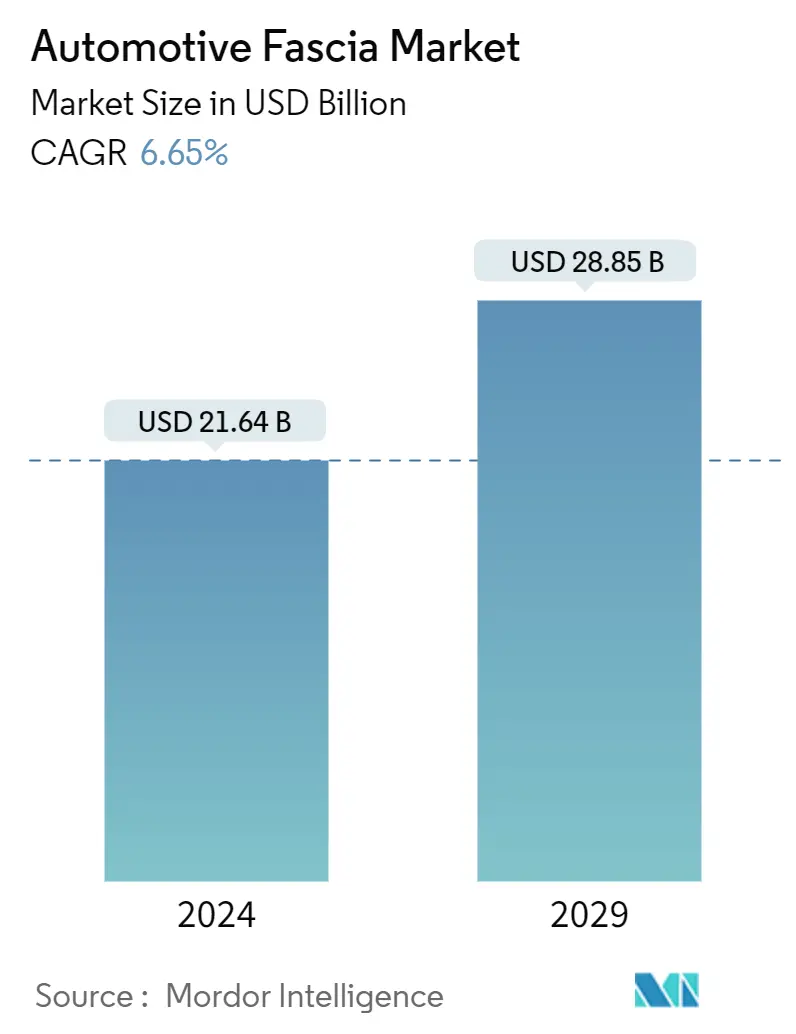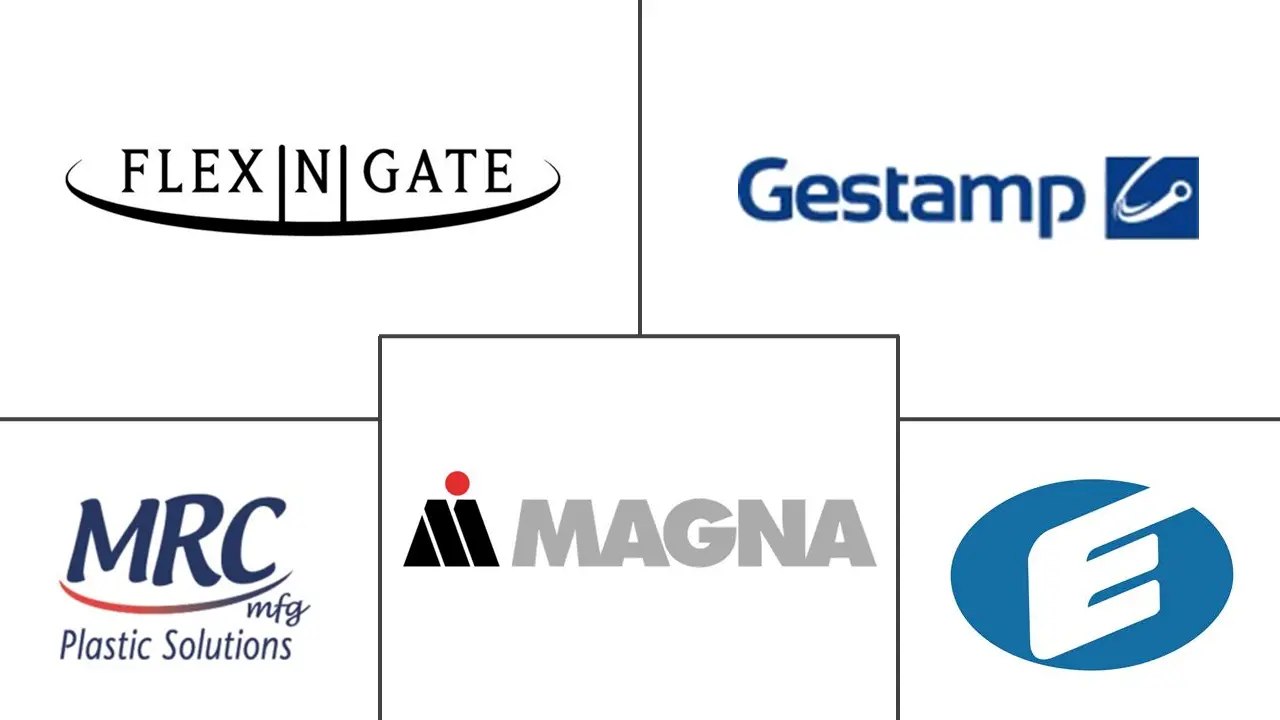Market Size of Automotive Fascia Industry

| Study Period | 2019 - 2029 |
| Market Size (2024) | USD 21.64 Billion |
| Market Size (2029) | USD 28.85 Billion |
| CAGR (2024 - 2029) | 6.65 % |
| Fastest Growing Market | Asia Pacific |
| Largest Market | Asia Pacific |
| Market Concentration | Medium |
Major Players
*Disclaimer: Major Players sorted in no particular order |
Automotive Fascia Market Analysis
The Automotive Fascia Market size is estimated at USD 21.64 billion in 2024, and is expected to reach USD 28.85 billion by 2029, growing at a CAGR of 6.65% during the forecast period (2024-2029).
Increasing vehicle sales, consumers' growing preference for the advanced look of vehicles, and rising demand for lightweight vehicle models serve as major determinants for the growth of the automotive fascia market across the globe. For instance, sales of new passenger cars recorded a growth of 1.9% between 2021 and 2022 across the world. Further, original equipment manufacturers (OEMs) across the world are eyeing to develop lightweight materials for designing fascia since the reduction in vehicle weight directly corresponds to a reduction in fuel consumption.
The development and modification of vehicles to offer consumers attractive-looking cars is further boosting the demand for automotive fascia, which helps in enhancing the aesthetics of a vehicle. Coupled with that, increasing luxury vehicle sales across various regions act as a catalyst for the rising demand for sustainable and advanced automotive fascia products. For instance,
Luxury vehicle sales in India witnessed a surge of 38% in the first six months of 2023 compared to the same period in the previous year. Approximately 20,000 luxury vehicles were sold between January and June 2023, which is estimated to cross the 40,000 mark by the end of the year.
In January 2023, Rolls Royce reported sales of 6,201 units of its luxury models across the world in 2022, showcasing an 8% growth Y-o-Y between 2021 and 2022, with the Middle East being its strongest market.
Coupled with that, aggressive government policy to regulate vehicle emissions and safety standards is positively impacting the surging growth of the automotive fascia market. For instance, The Euro 6 emission standard sets a legal requirement for a car manufacturer to average CO2 emissions below 98g/km, which is leading to the development of innovative materials utilized in a vehicle. Policies such as this also contribute to the development of lightweight parts by automotive manufacturers, which in turn assists in weight reduction and complying with the government's safety standards of vehicles, thereby positively impacting the automotive fascia market.
The high cost of installation and replacement is a major deterrent to the growth of the market. There exists a substantial cost requirement for replacing the fascia once damaged owing to the improved and advanced plastic used for the manufacturing of these products. Therefore, replacing this component of the vehicle further increases the vehicle's operating cost, which negatively impacts the growth of the market.
Rising demand for new-age vehicles such as autonomous vehicles and electric vehicles, increasing sales of used cars, and the growing demand for high-end cars attributed to the growth in disposable income are expected to fuel the growth of the automotive fascia market in the coming years.
Automotive Fascia Industry Segmentation
Automotive fascia refers to a decorative panel that is mounted on top of the bumper at the front and rear end of the vehicle. A bumper valance panel, a piece that is mounted on top or under the bumper is also considered a part of the automotive fascia. Further, automotive fascia comprises space for grilles, headlamps, bumpers, and vehicle emblems, among others, and is designed to provide a unified appearance to a vehicle.
The automotive fascia market is segmented into position type, material, vehicle type, sales channel, and geography. Based on the position type, the market is segmented into front fascia and rear fascia. Based on the material, the market is segmented into plastic-covered styrofoam, plastic-covered aluminum, and other materials (steel, rubber, etc.). Based on vehicle type, the market is segmented into passenger cars and commercial vehicles. Based on sales channel, the market is segmented into original equipment manufacturer (OEM) and aftermarket. Based on geography, the market is segmented into North America, Europe, Asia-Pacific, and Rest of the World.
For each segment, the market sizing and forecast have been mentioned based on value (USD).
| By Position Type | |
| Front Fascia | |
| Rear Fascia |
| By Material | |
| Plastic Covered Styrofoam | |
| Plastic Covered Aluminum | |
| Other Materials (Steel, Rubber etc.) |
| By Vehicle Type | |
| Passenger Cars | |
| Commerical Vehicles |
| By Sales Channel | |
| Original Equipment Manufacturer (OEM) | |
| Aftermarket |
| By Geography | |||||||
| |||||||
| |||||||
| |||||||
|
Automotive Fascia Market Size Summary
The automotive fascia market is poised for significant growth, driven by increasing vehicle sales and a rising consumer preference for advanced and aesthetically appealing vehicle designs. The demand for lightweight vehicle models is also contributing to this growth, as manufacturers focus on developing materials that reduce vehicle weight and, consequently, fuel consumption. The market is further bolstered by the surge in luxury vehicle sales, which demand sustainable and innovative fascia products. Government regulations aimed at reducing vehicle emissions and enhancing safety standards are encouraging the development of lightweight and eco-friendly materials, positively impacting the automotive fascia market. However, the high cost of installation and replacement of fascia components remains a challenge, potentially hindering market expansion.
The market's growth is also fueled by the rising demand for new-age vehicles, such as electric and autonomous cars, and the increasing sales of used cars, driven by growing disposable incomes. The shift towards private transportation and the expansion of urban populations, particularly in the Asia-Pacific region, are further propelling the market. Government initiatives promoting green mobility and infrastructure development are expected to enhance the demand for advanced automotive fascia products. The market is highly competitive, with major players investing in sustainable materials and engaging in strategic partnerships to expand their reach. Innovations in design and technology, such as those seen in recent automotive models, underscore the dynamic nature of the automotive fascia market.
Automotive Fascia Market Size - Table of Contents
-
1. MARKET DYNAMICS
-
1.1 Market Drivers
-
1.1.1 Increasing Vehicle Sales
-
1.1.2 Others
-
-
1.2 Market Restraints
-
1.2.1 High Maintenance and Replacement Cost
-
-
1.3 Industry Attractiveness - Porter's Five Forces Analysis
-
1.3.1 Threat of New Entrants
-
1.3.2 Bargaining Power of Buyers/Consumers
-
1.3.3 Bargaining Power of Suppliers
-
1.3.4 Threat of Substitute Products
-
1.3.5 Intensity of Competitive Rivalry
-
-
-
2. MARKET SEGMENTATION (Market Size in Value - USD)
-
2.1 By Position Type
-
2.1.1 Front Fascia
-
2.1.2 Rear Fascia
-
-
2.2 By Material
-
2.2.1 Plastic Covered Styrofoam
-
2.2.2 Plastic Covered Aluminum
-
2.2.3 Other Materials (Steel, Rubber etc.)
-
-
2.3 By Vehicle Type
-
2.3.1 Passenger Cars
-
2.3.2 Commerical Vehicles
-
-
2.4 By Sales Channel
-
2.4.1 Original Equipment Manufacturer (OEM)
-
2.4.2 Aftermarket
-
-
2.5 By Geography
-
2.5.1 North America
-
2.5.1.1 United States
-
2.5.1.2 Canada
-
2.5.1.3 Rest of North America
-
-
2.5.2 Europe
-
2.5.2.1 United Kingdom
-
2.5.2.2 Germany
-
2.5.2.3 France
-
2.5.2.4 Spain
-
2.5.2.5 Rest of Europe
-
-
2.5.3 Asia-Pacific
-
2.5.3.1 China
-
2.5.3.2 India
-
2.5.3.3 Japan
-
2.5.3.4 South Korea
-
2.5.3.5 Rest of Asia-Pacific
-
-
2.5.4 Rest of the World
-
2.5.4.1 South America
-
2.5.4.2 Middle-East and Africa
-
-
-
Automotive Fascia Market Size FAQs
How big is the Automotive Fascia Market?
The Automotive Fascia Market size is expected to reach USD 21.64 billion in 2024 and grow at a CAGR of 6.65% to reach USD 28.85 billion by 2029.
What is the current Automotive Fascia Market size?
In 2024, the Automotive Fascia Market size is expected to reach USD 21.64 billion.

